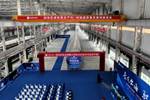Blade2Circ project to facilitate sustainable next-gen wind blade designs
Coordinated by the Aitiip Technology Centre, the EU-funded project will design components to facilitate improved recyclabilty, exploring the performance of bio-based material options and novel degradation processes.
Europe generates more than 70% of the world’s energy from wind energy, meeting almost 14% of the European Union’s (EU) global electricity demand. However, the rapid growth of wind farms still poses challenges, particularly when it comes to their end-of-life (EOL) management. To address this issue and promote a more sustainable future for wind energy, Aitiip Technology Center (Zaragoza, Spain) has announced the Blade2Circ project.
The EU-funded project aims to develop a new generation of wind turbine blades using high-performance bio-based composite materials. This initiative, with a budget of almost €4 million, is led by Aitiip and brings together a consortium of 11 partners from France, Sweden, Belgium, Ireland and Spain — including Moses Products, University of Limerick, CSIC, Evoenzyme, Specific Polymers, Centexbel, ITA, ÉireComposites, KTH and Incotec.
Blade2Circ aims to improve the recyclability of wind turbines by designing components that facilitate the dismantling of blades, such as a reversible adhesive, and developing new chemical and enzymatic degradation processes to address the EOL of resins. The project will also investigate methods to improve blade performance, extend blade life and facilitate efficient decommissioning, promoting circularity along the entire value chain.
Blade2Circ will contribute to:
- Improving global sustainability by exploring the performance of new composite materials and reversible bio-based resins, offering a greener alternative to traditional petroleum-based materials. In addition, it will develop new chemical and enzymatic degradation processes to optimize the recyclability of the blades.
- Enhancing circularity and efficiency by developing innovative processes such as self-healing coatings, improving separation efficiency and value retention.
The Blade2Circ project is funded by the European Commission under Pillar II (Cluster 5 – Climate, Energy and Mobility). It began on April 1, 2024, and will last for 42 months.
Related Content
-
TU Munich develops cuboidal conformable tanks using carbon fiber composites for increased hydrogen storage
Flat tank enabling standard platform for BEV and FCEV uses thermoplastic and thermoset composites, overwrapped skeleton design in pursuit of 25% more H2 storage.
-
Plant tour: Joby Aviation, Marina, Calif., U.S.
As the advanced air mobility market begins to take shape, market leader Joby Aviation works to industrialize composites manufacturing for its first-generation, composites-intensive, all-electric air taxi.
-
Bio-based acrylonitrile for carbon fiber manufacture
The quest for a sustainable source of acrylonitrile for carbon fiber manufacture has made the leap from the lab to the market.














